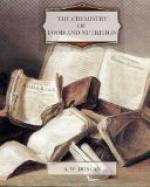Dr. George S. Keith, in “Fads of an Old Physician,” has a chapter on rheumatic fever; he says that the disease is much more common than it was fifty years ago. He has never met with it in the young or old except when the diet had consisted largely of beef and mutton, and this although he has been on the outlook for at least forty years for a case of the disease in a child or youth who had not been fed on red meat. He speaks of it as being exceedingly common in Buenos Ayres and Rosario in the Argentine Republic, amongst the young; and that it leads to most of the heart disease there. The amount of meat, especially of beef, consumed by old and young is enormous. The main evils there, were anaemia in children and neuralgia both in old and young. Dr. Haig relates how he suffered from migraine all his life, until the time of his discontinuing butchers’ meat. As meat contains a comparatively large quantity of purins and other bodies called extractives, it is probable that such quantities have an injurious effect, quite apart from the question of uric acid production. That an excessive meat diet lessens the vitality of the body and pre-disposes to disease is undoubted, but opinions differ as to how the injury is brought about.
On thorough Mastication.—We have written at some length on the quantity and constituents of food required per day and have criticised the usually accepted standards. We have since read a valuable contribution to the subject by Mr. Horace Fletcher in his book, “The A.B.-Z. of our own nutrition” (F.A. Stokes & Co., New York). Ten years previous to the writing of the book, when of the age of 4, he was fast becoming a physical wreck, although he was trained as an athlete in his youth and had lived an active and most agreeable life. He had contracted a degree of physical disorder that made him ineligible as an insurance risk. This unexpected disability and warning was so much a shock, that it led to his making a strong personal effort to save himself. He concluded that he took too much food and too much needless worry. His practice and advice is, be sure that you are really hungry and are not pampering false appetite. If true appetite that will relish plain bread alone is not present, wait for it, if you have to wait till noon. Then chew, masticate, munch, bite, taste everything you take in your mouth; until it is not only thoroughly liquefied and made neutral or alkaline by saliva, but until the reduced substance all settles back in the folds at the back of the mouth and excites the swallowing impulse into a strong inclination to swallow. Then swallow what has collected and has excited the impulse, and continue to chew at the remainder, liquid though it be, until the last morsel disappears in response to the swallowing impulse. In a very short time this will become an agreeable and profitable fixed habit. Mr. Fletcher has been under the observation of several eminent scientific men. Professor R.H. Chittenden, of Yale University, in his report




